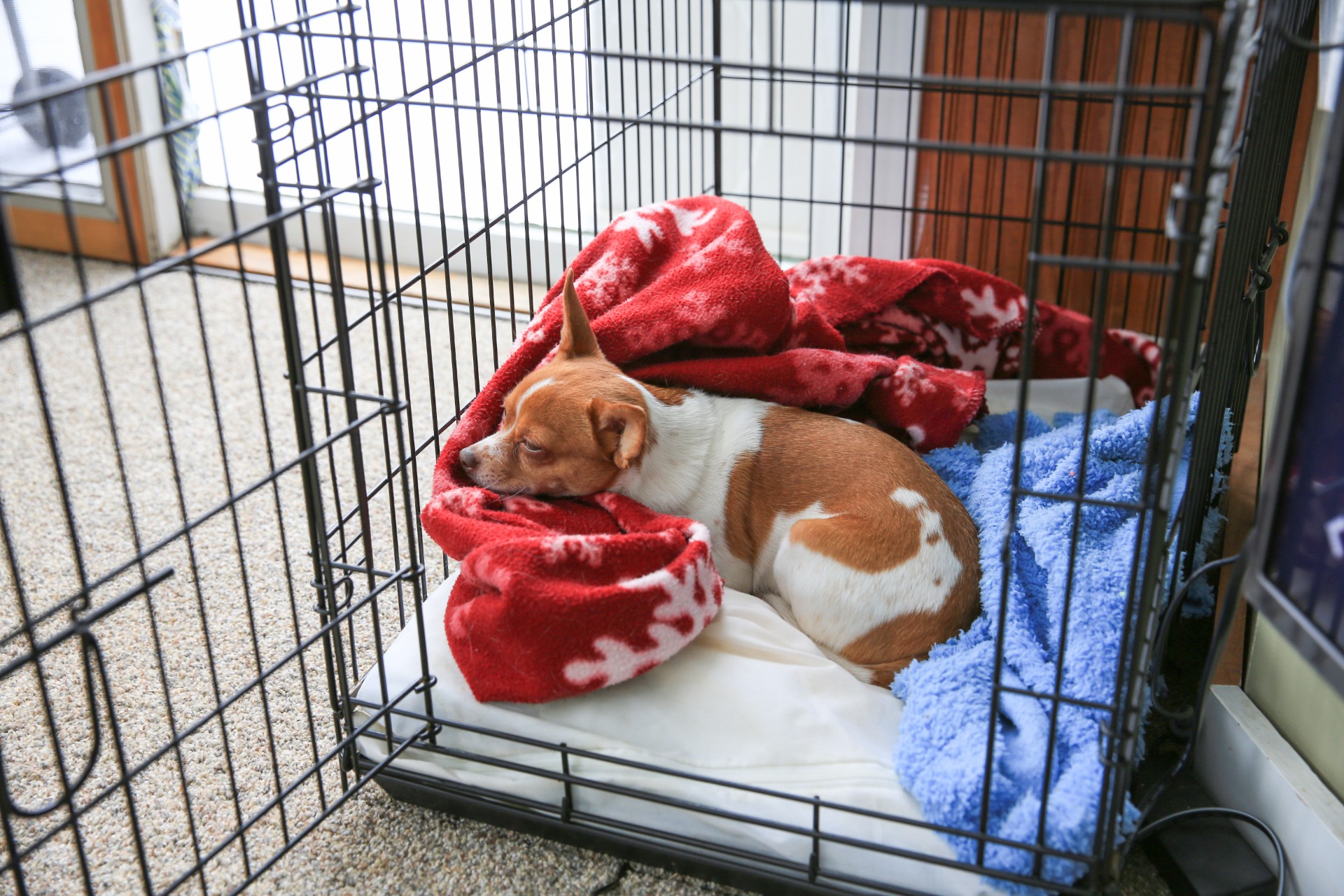Crate training your dog is a convenient and safe way to help your dog make good decisions while you’re out of the house, but crates don’t exactly fit into typical household decor. Disguising the crate or dressing it up can help balance your dog’s needs with your style.
There are a few things you can do to help keep your crate looking nice. But pay attention! Not everything is safe for your dog or good for your home. Here’s what you need to know about decorating your dog’s crate and how to keep everyone safe.

Crate decorating ideas
Whether you’re disguising your crate or dressing it up for the holidays, there are a lot of fun and creative ideas for decorating dog crates out there. Here are some of our favorites.
Disguise your crate underneath countertops
If you have counters in your kitchen or a mudroom with room to spare, replacing the cabinet facing with crate wiring. This can help your dog feel at ease while blending in with the decor of your home.
This option is convenient because if you ever move or want to convert crate space back to cabinetry, you have the skeleton in place. This can be an easy conversion in either direction if you have some experience with power tools.
Use crate furniture
Investing in crate furniture helps you blend and style your crate with the rest of your household decor. You can get crate end tables and place non-breakable accessories on top. You can get a durable, larger crate and secure shelving to the top for a bedroom built-in.
When you invest in furniture, ensure that your pet still has room to sit down without bending, lie down comfortably, and turn around easily. If that size doesn’t fit your intended space, it’s not a good idea.
Use live plants
Adding in live plants to the area is a wonderful way to promote calming around your dog, but keep in mind — safety first. Above all, find plants that are nontoxic to dogs and keep them out of reach of your dog’s crate.
You can also place a wood board on top of your crate and put plants on it. Be sure to use planters with wide bases so your dog’s movement doesn’t accidentally knock them over.
Here are some typically pet-safe plants:
- Spider plant
- Boston fern
- Rosemary
- Marigolds
- Pineapple sage
- Polka dot plants
And some you must avoid:
- Lilies
- Cyclamen
- Ivy
- Umbrella plants
Neither of these is an exhaustive list, so be sure to do your research and consult with your veterinarian.
Soft interior materials
Decorating the inside of your pet’s crate can be a snap with modern materials and fun-looking toys. Keep in mind that all materials should be washable, and if you have a puppy or a senior dog, waterproofing is a great option.
Materials shouldn’t be so thick that your dog can overheat, and make sure your crate isn’t next to a heating or air conditioning vent. Otherwise, crate mats with removable covers can be a fun way to dress up the crate for holidays or seasonal changes.
Things to avoid when decorating a crate
Some items are too much of an issue to have in or around your pet’s crate, so keep this in mind:
- Hooks — While those bars may seem like the perfect place to hang little accessories, dogs may ingest hooks and suffer injury or even death. In fact, leave the bars as free as possible for air circulation and safety.
- Toys with batteries or small pieces — If you aren’t able to supervise your pet, these toys can also pose a hazard. Dogs may chew through the material or bite off a piece and choke or ingest something dangerous.
- Lights and electric cords — Again, while those Christmas lights may look adorable to you, if your pet chews through the wire, it’s a fire and safety hazard. Keep all cords well out of reach of your dog’s crate.
- Heavy or breakable materials — Your dog’s movements may topple things over, so be careful what you put on top of the crate. Even with a wooden top, your dog may still be able to knock things over.
Creating a safe, healthy crate environment

Your dog’s crate should be a safe place. Ensure that anything in or around your dog’s crate is safe enough to nibble on or chew. Otherwise, it’s best to move those things well out of the way. Ensure your pet has plenty of air circulation and isn’t near a heat or air vent to prevent breathing and temperature issues.
Otherwise, get creative when incorporating fun dog crate decorating ideas into your home’s decor. These tips will help you safely disguise or decorate your pet crate and look great in your home. You don’t have to sacrifice all your design style to have a crate; it’s just a matter of seeing things differently. If you want to know more, you can check our guide on puppy-proofing your apartment.


